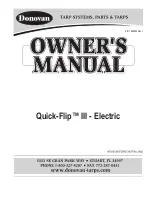
STEERING SYSTEM 9B-27
TROUBLESHOOTING THE HYDRAULIC PUMP
PUMP NOISE
The power steering pump is not completely
noiseless. Some noise will be present whenever
the wheels are against the wheel stops. The noise
usually becomes greater as engine speed is in
creased as when making a full cramped U-turn.
The noise is caused by the relief valve and is norm
al. Momentary aeration of the oil is sometimes
noticeable under these conditions. Some noise may
also be present under standstill parking condition,
particularly when the wheel stops are contacted.
Power steering pump noise can be confused with
many other things such as transmission, rear axle,
generator, etc. If it determined that excessive
noise is present, remove the pump drive belt to
make sure the pump is at fault. If it is determined
that the pump is at fault proceed as follows:
1. Check Drive Belt Tightness. Adjust belt
tension, if necessary, as described previously
under "Pump Belt Tension Adjustment."
2. Check Oil Level. Refill, if necessary, as
described in L U B R IC A T IO N (S E C . 0) of this manual.
3. Check Hose. Make sure hose is not touch
ing any other parts of the vehicle, especially the
sheet metal.
4. Check for Presence of Air in the Oil. Air
will show up as bubbles or oil will appear milky.
Small amounts of air cause extremely noisy oper
ation. If air is present in oil accomplish the fol
lowing:
POOR, OR NO ASSIST, OR
PUMP INOPERATIVE
When the pump is inoperative, providing little
or no assist in turning, first check the belt tension
and adjust it as necessary, as previously described.
If this does not correct the problem, check the oil
level, fill and bleed the system as described pre
viously.
If there is no improvement, it must be estab
lished whether the pump, steering gear, or hose
are the source of trouble. This may be determined
by two tests after placing a pressure gauge in the
a. Tighten all fittings and bolts.
b. Check the entire system for source of air
leak. Air can leak into the system at any place.
Air leaks usually occur at joints in the system
where oil passes through at high velocity - such as
hose connections or at the drive shaft seal.
N O T E : After each step in attempting to elim
inate air, the pump should be operated for a few
minutes at idle speed while occasionally turning
the steering wheel between extreme turns to allow
air to bleed out of oil.
5. After Eliminating Air From the Oil. Install
a pressure gauge in the pressure line between the
pump and steering gear. If, when racing the engine
to about 1000 rpm and without turning the wheels,
pressure exceeds 125 psi, the hose and/or the
steering gear are restricting the oil flow. These
parts should be examined to determine cause of
restriction.
6. If the Pressure is Less Than 125 Psi in
Step 5 Above, remove the pump and repair.
PUMP LEAKS
Whenever oil leakage occurs in the hydraulic
pump, all fittings and bolts should be cleaned and
tightened. If this does not stop leakage, wipe pump
assembly clean to determine where it is leaking.
Following are some of the possible causes of pump
leakage: (See table below.)
pressure line between pump and steering gear.
Test #1 is Performed With the Oil Circuit
Open. Raise the temperature of oil to operating
range of 150 to 170 degrees measured with a ther
mometer. This may be accomplished by turning
the wheels from wheel stop to wheel stop several
times. Do not hold steering wheel against wheel
stop for any extended period as this will overheat
the oil. As previously mentioned, the pressure
relief valve in the pump will not be able to handle
the excessive pressure created by contacting the
wheel stop for an extended period of time, there
fore, the oil will overheat.
S O U R C E O F L E A K
C A U SE
R E M E D Y
Top of reservoir . . .
Reservoir too full................................ . Fill to proper level.
At the pressure
Air in the oil. .................................... . Eliminate air as previously
described under "Pump Noise."
fitting or studs . . . .
Not tightened sufficiently..................
Cross threaded or defective seat on
. Torque to 25-40 foot-pounds.
fittings or hose end. Damaged seals.
. Correct as necessary.
At shaft seal .............
Defective seal or damaged shaft.
. . . Replace damaged parts.
Leaks in metal parts .
Damaged castings................................ . Replace damaged parts.
CHEVROLET SERIES 70 -80 H EAVY DUTY TRUCK SH OP M A N U A L
Summary of Contents for 70 1969 Series
Page 1: ...CHEVROLET HEAVY DUTY TRUCK SHOP MANUAL...
Page 3: ......
Page 11: ...LUBRICATION 0 4 CHEVROLET SERIES 70 80 HEAVY DUTY TRUCK SHOP MANUAL...
Page 27: ......
Page 119: ......
Page 361: ......
Page 371: ......
Page 427: ......
Page 443: ......
Page 451: ......
Page 493: ......
Page 499: ......
Page 549: ......
Page 555: ......
Page 609: ......
Page 715: ...am...
Page 745: ......
Page 910: ......
Page 913: ......



































